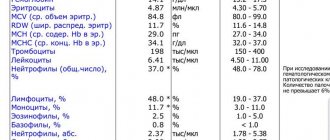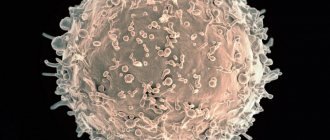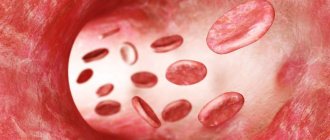From the article you will learn the norm of lymphocytes (LYM, LYMPH in a blood test) for adults and children, the reasons for the increase and decrease in cell concentration.
Lymphocytes (LYM, LYMPH) are the main cells of the immune system, which are responsible for all of our internal defenses. If we decipher the word “lymphocytes” itself, it consists of two ancient Greek words – lymph and cytos.
Lymph is a container, and cytos is a cell. Lymphocytes are representatives of white blood cells, which are the main cells of the immune system. From the moment they appear in the bone marrow until they must perform their particularly important function - to stand on our internal genetic purity - a certain period of time passes.
Types of lymphocytes
When the bone marrow releases a young lymphocyte into the bloodstream, it is not yet ready to perform its most delicate functions. Some of the young cells, lymphocytes, go to the thymus, or thymus gland, and there they must undergo maturation or “training.” What does "training" mean? A young lymphocyte must become familiar with the antigens that our body has encountered throughout life, starting from prenatal development. After maturation, thymus-dependent lymphocytes (T-lymphocytes) will begin to recognize antigens, understand that these are genetic strangers and will be ready to carry out their tasks.
T lymphocytes
There are several types of T-lymphocytes.
The first type is killer T-cells. Killers are killers. They are the ones who are sharpened to recognize a genetic stranger and try to kill him right away.
The second type is T-helper cells, or helper cells. It is the T helper cells that will include the following cells that will produce antibodies or protective protein structures for us.
The third type is T-suppressors - those cells that will stop the immune response.
And so, if a genetic alien enters the human body, the killers will be the first to recognize it and will try to kill it immediately. What can act as a genetic stranger? These are viruses, bacteria, parasites, fungi, and cancer cells that can appear every second. Cells of the body in which a failure occurred at the genetic level. If a person has food intolerance, then, unfortunately, they can also turn into genetic strangers and also deplete the lymphocyte component of the immune system.
B lymphocytes
These are also lymphocytes, which, having emerged young from the bone marrow into the bloodstream, rush to the lymph nodes, to the spleen, or to the liver, where they will also mature. The main function of B cells is to produce representatives of humoral immunity, or blood immunity, for us. It is the B cells that will produce antibodies that will fight viruses, bacteria, and other genetic invaders.
NK cells or natural killer cells
This is a group of cells that will primarily be focused on protecting us from cancer. First of all, natural killers will work in antitumor defense and antiparasitic defense. NK cells are the main types of lymphocytes.
Lymphocytes are the final link
Lymphocytes are responsible for the final action of the immune system, processing antigens already prepared by monocytes and other cells. They are responsible for acquired immunity, which will prevent the infection from acting again. Lymphocytes produce antibodies and memory cells. Like other cells, lymphocytes are produced in the bone marrow but circulate in both the blood and the lymphatic system. Cell maturation is influenced by the thymus and lymph nodes. The group of lymphocytes is the second most numerous in the blood.
To identify cells in the blood, a special test called immunophenotyping is used. Thanks to this study, it is possible to determine the specific number of this type of cell. Determining specific types of lymphocytes makes it possible to diagnose and treat diseases of the immune system, HIV infections and others.
The leukocyte formula indicates the increase and decrease in the number of lymphocytes. Both indicators are very important. Lymphocytosis, or an increase in the number of cells, indicates viral infections, as does a decrease (lymphopenia). A decrease in the number of lymphocytes significantly reduces the protective function of the body, which is typical for people with immunodeficiency.
The norm of lymphocytes in the blood in adults and children
Unfortunately, there are often situations when lymphocytes in the blood can deviate from the norm - increase or decrease. This can happen in various situations. Before we talk about when the number of lymphocytes changes in the blood, we need to talk about how much is their normal component.
If we talk about cell clones, then:
T cells make up 75% of the total number of lymphocytes;
B cells about 15%;
Natural killers are about 10%.
And speaking about the norms of lymphocytes, it must be said that at different periods of a person’s life the norms differ.
Lymphocytes begin to be produced by the bone marrow already in utero, and this process continues throughout life. The lifespan of these cells also varies - from several months to sixty years. And these will all be lymphocytes.
- Up to 1 year, the content of lymphocytes in the blood of the total number of all cells is 45-70%.
- From 1-2 years, the concentration of lymphocytes should decrease - somewhere around 39-60%.
- From 2-4 then somewhere from 33-50% of all white cells.
- From 4-10 years, already 30-50%.
- From 10-18 years old, then this is already 30-44%.
- In an adult, lymphocytes in the blood should range from 19-37%.
The table shows the values of acceptable norms of lymphocytes (individual subpopulations) in the blood of children and adults.
| Age | Proportion of the total number of lymphocytes, % | Absolute cell count, *106/l |
| CD 3+ (T lymphocytes) | ||
| Up to 3 months | 50 – 75 | 2065 – 6530 |
| Up to 1 year | 40 – 80 | 2275 – 6455 |
| 1 – 2 years | 52 – 83 | 1455 – 5435 |
| 25 years | 61 – 82 | 1600 – 4220 |
| 5 – 15 years | 64 – 77 | 1410 – 2020 |
| Over 15 years old | 63 – 88 | 875 – 2410 |
| CD3+CD4+ (T helper cells) | ||
| Up to 3 months | 38 – 61 | 1450 – 5110 |
| Up to 1 year | 35 – 60 | 1695 – 4620 |
| 1 – 2 years | 30 – 57 | 1010 – 3630 |
| 25 years | 33 – 53 | 910- 2850 |
| 5 – 15 years | 34 – 40 | 720 – 1110 |
| Over 15 years old | 30 – 62 | 540 – 1450 |
| CD3+CD8+ (T-cytotoxic lymphocytes) | ||
| Up to 3 months | 17 – 36 | 660 – 2460 |
| Up to 1 year | 16 – 31 | 710 – 2400 |
| 1 – 2 years | 16 – 39 | 555 – 2240 |
| 25 years | 23 – 37 | 620 – 1900 |
| 5 – 15 years | 26 – 34 | 610 – 930 |
| Over 15 years old | 14 – 38 | 230 – 1230 |
| CD19+ (B lymphocytes) | ||
| Up to 2 years | 17 – 29 | 490 — 1510 |
| 25 years | 20 – 30 | 720 – 1310 |
| 5 – 15 years | 10 – 23 | 290 – 455 |
| Over 15 years old | 5 – 17 | 100 – 475 |
| CD3-CD16+CD56+ (NK cells) | ||
| Up to 1 year | 2 – 15 | 40 – 910 |
| 1 – 2 years | 4 – 18 | 40 – 915 |
| 25 years | 4 – 23 | 95 – 1325 |
| 5 – 15 years | 4 – 25 | 95 – 1330 |
| Over 15 years old | 4 – 27 | 75 – 450 |
| Over 15 years old | 1 – 15 | 20-910 |
What indicators are included in the UAC?
The general blood test includes the following indicators: red blood cells, hemoglobin, leukocytes, color index, hematocrit, reticulocytes, platelets, ESR.
The leukocyte formula in some laboratories is signed by default, in some a doctor’s note is required. It includes the following indicators: eosinophils, basophils, band and segmented neutrophils, lymphocytes, monocytes.
Below is a table of norms for a general blood test:
| Index | Laboratory designation | Norma (women) | Norma (men) | Unit |
| Red blood cells | R.B.C. | 3,8-4,5 | 4,4-5,0 | 1012/l |
| Hemoglobin | HGB | 120-140 | 130-160 | g/l |
| Leukocytes | WBC | 4,0-9,0 | 4,0-9,0 | 109/l |
| Color index | CPU | 0,8-1,0 | 0,8-1,0 | |
| Hematocrit | HCT | 35-45 | 39-49 | % |
| Reticulocytes | RET | 0,2-1,2 | 0,2-1,2 | % |
| Platelets | PLT | 170,0-320,0 | 180,0-320,0 | 109/l |
| ESR | ESR | 2-15 | 1-10 | mm/hour |
| Leukocyte formula: | ||||
| Basophils | BAS | 0-1 | 0-1 | % |
| Eosinophils | EO | 0,5-5 | 0,5-5 | % |
| Myelocytes | 0 | 0 | % | |
| Metamyelocytes | 0 | 0 | % | |
| Band neutrophils | NEUT | 1-6 | 1-6 | % |
| Segmented neutrophils | NEUT | 47-67 | 47-67 | % |
| Lymphocytes | LYM | 18-40 | 18-40 | % |
| Monocytes | MON | 3-11 | 3-11 | % |
At some points, the standard blood test for adults differs from that for children.
For example, the norm of hemoglobin in a child is 110-145 g/l, leukocytes 5.0-12.0 109/l, the content of lymphocytes can be in the range of 26-60%. The remaining blood test parameters correspond to the reference values for adults.
By order of the Ministry of Health, in the first year of life, a child’s blood is taken for general analysis 4 times, then at 1 year 6 months, and then annually, starting from two years. Such measures are necessary for the early detection of blood diseases, anemia, and infections.
Causes of increased lymphocytes in the blood in adults
What does it mean? The causes of elevated lymphocytes in the blood in women and men may be different, but there are several types of diseases that most often lead to this phenomenon:
- infectious diseases;
- bacterial infections;
- autoimmune diseases;
- acute allergies and anaphylactic shock are possible;
- the appearance and growth of malignant and benign tumors and neoplasms;
- especially pronounced lymphocytosis will be in tests for diseases that can be suffered only once (measles, rubella, chickenpox, mononucleosis, etc.);
- autoimmune processes.
Leukocytes - what are they?
Leukocytes are the body’s protective army. They make up a large group of white blood cells whose purpose is to rid the body of infections. Leukocytes take part in allergic, autoimmune and tumor processes. White cells are divided into types, which are responsible for their specific function.
A complete blood count shows the total number of cells. The leukocyte count is responsible for accurately identifying the cell types that cause an increase (leukocytosis) or decrease (leukopenia) in white cells in the blood. The formula can be found in an expanded form of a blood test. There are five types of cells, their number and relationship to each other.
The blood test is assessed using an automatic analyzer, which calculates the percentage of each type of the total number of cells. The device also calculates the white blood cell count per liter of blood.
Additionally, a visual assessment of the blood smear using a microscope may be required. A “manual” check of analyzes may be necessary in the following cases:
• Changes in the leukocyte formula; • There are altered or immature cells; • Signs of anemia are visible; • Reduced platelet count.
If the analysis is processed manually, only the percentage will be visible. Each type of assessment allows you to correctly diagnose diseases, understand their causes and prescribe the correct treatment.
Lymphocytes are higher than normal in children
In children 4-5 days and 4-5 years of age, physiological lymphocytosis is observed in the blood, which does not require treatment. The child’s condition remains completely normal, the lymph nodes do not enlarge. This situation is due to the restructuring of the child’s hematopoietic system.
However, an increased lymphocyte count in children may be caused by:
- Leukemia;
- Bronchial asthma;
- Infection: influenza, ARVI, sore throat and others;
- Purulent-inflammatory processes;
- Viral diseases: lichen, whooping cough, malaria, varicella (chickenpox), measles, viral hepatitis and others.
Lymphocytes can also be elevated during other diseases, with various individual characteristics of the body. The exact reasons can only be determined after a full examination.
What to do when there are high lymphocytes in a blood test
If lymphocytes are elevated, what should you do in this case? There can be only one answer: to identify and eliminate the cause of this condition. When lymphocytes are elevated, treatment should not be aimed at reducing their level, but at the disease itself.
Depending on the disease, therapy takes from several days to several months and usually helps stabilize the level of lymphocytes. For example, for most infectious processes, anti-inflammatory, antipyretic, antiviral drugs, as well as antibiotics are prescribed. The course of treatment for myeloma and leukemia is very unique and often requires chemotherapy and bone marrow transplantation.
What do granulocytes say?
Part of the leukocytes are granulocytes, which get their name due to the presence of granules. There are three types of cells: neutrophils, eosinophils and basophils. The types of granulocytes differ from each other due to the color of the granules and the structure of the nucleus.
The granules store immune substances that are important for protecting the body. Thanks to them, cells participate in inflammatory processes. The job of granulocytes is to absorb proteins and chemicals. Granulocytes also digest them.
The cells mature in the bone marrow, where the resulting quantity is stored for another 3-4 days. Mature cells enter the blood, where they circulate for 6 hours. After the end of the cycle, granulocytes enter the tissues, where they perform their functions.
The largest number of leukocytes are neutrophils, of which there are always about 1010 in the blood. If a bacterial infection enters the body, neutrophilia begins - an increased amount of neutrophils in the blood. The number of cells that appear depends on the number of harmful bacteria.
The duration of stay of neutrophils in the body is only 4 days, which is why still immature cells (band cells, metamyelocytes, and others) enter the body. This phenomenon is called a “shift of the leukocyte formula to the left.” With neutropenia (reduced number of neutrocytes), the body is less protected from infections.
About 5% of leukocytes are eosinophils, the number of which depends on adrenal hormones. In the morning there are the largest number of them. They are stored in the layer under the mucous membrane of the gastrointestinal tract. A quantity above the norm indicates that the following processes are occurring in the body:
- Infestation with parasites;
- Allergy;
- Autoimmune processes.
Medical offers to sign up for diagnostics and tests. In our laboratory it is possible to take all types of tests in Tula. Tel. for recording.
The smallest number (less than 1%) are basophils. They play a role in the release of histamine during allergic reactions. It is these cells that are responsible for itching, redness, irritation and bronchial spasms.
Depending on the location of basophils in the body, the following reactions differ:
- Bronchial asthma;
- Rashes
- Hives;
- Quincke's edema (swelling of the larynx).











